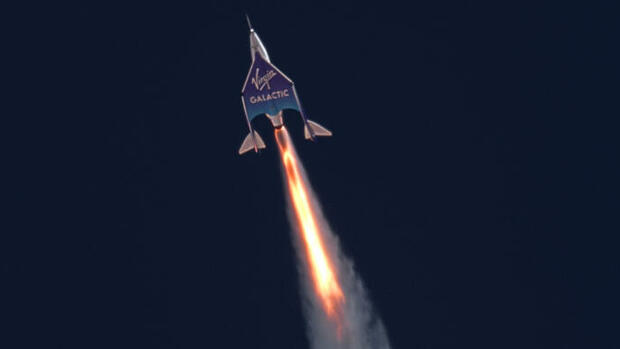Dusseldorf On Thursday at 5 p.m. German time, the time has come: Virgin Galactic’s first commercial flight will take off from an airport in the US state of New Mexico. For the company founded in 2004 by billionaire Richard Branson, it is probably the most important flight in the company’s history. After numerous test flights, the spacecraft “VSS Unity” takes paying customers into space for the first time.
Three members of the Italian Air Force and the National Research Council of Italy plan to spend several minutes in zero gravity to carry out a series of scientific experiments. Michael Colglazier, head of Virgin Galactic, speaks of a “new era of repeatable and reliable access to space”.
The timing is met with criticism. The flight comes just days after the Titan submersible crashed, in which passengers paid for the trip to the wreck of the Titanic with their lives. “That can’t be true, do we have to do something like this again?” asked a user on Twitter. “Can you also control it with a Logitech controller?” wrote another, alluding to the controls of the crashed submersible.
The mockery has a serious background. “Both companies use untested technologies,” says Ulrich Walter, Professor of Aerospace Engineering at the Technical University of Munich. Submersible operator Oceangate used carbon fiber instead of steel for the hull. Virgin Galactic is also breaking new ground with its hybrid approach of flight and space technology.
However, Walter estimates Virgin Galactic’s chances of success as very high. Unlike the “Titan”, there were many tests, and the US aviation authority FAA gave the green light. “They take a very close look,” says the former astronaut. In contrast, the Oceangate submersible was deliberately used in international waters to avoid inspections.
A carrier plane brings the spaceship up
Other companies like Elon Musk’s SpaceX and Jeff Bezos’ Blue Origin also take tourists into space, but they rely on conventional rocket launches. Virgin Galactic, on the other hand, wants to save costs with a mixture of aerospace.
>> Read also: The extreme travel business is booming – despite the risks
Instead of taking off from Earth, the Spaceship Two spacecraft will be launched with a carrier aircraft and released at an altitude of 15 kilometers. Only then does the “VSS Unity” ignite its rocket motors to bring the six-man crew to an altitude of around 88 kilometers. Although the combination is unusual, the technologies such as that of the airplane or rocket propulsion have been tried and tested for a long time, says space expert Walter.
With one exception: the extension of the so-called spring position. The spacecraft’s wings are extended to slow down the return – similar to a badminton ball. “That pushes the limits of the material,” says Walter. The speed is extremely high and the technology is comparatively new.
So far, parachutes and heat shields have been used to decelerate missiles. The process, devised by aeronautical engineer Burt Rutan more than 20 years ago, makes this superfluous. But the dangers are great. “An incorrect angle or a wing does not extend completely,” warns Walter, “and then disaster strikes.”
The spacecraft is launched with a carrier aircraft and released at an altitude of 15 kilometers.
(Photo: dpa)
During a test flight in 2014, the co-pilot released the spring position too early, the spaceship “VSS Enterprise” crashed – only the pilot survived with serious injuries.
New spacecraft Delta to fly weekly
The new spaceship “VSS Unity” has so far successfully passed numerous glide and flight tests, the last one just a few weeks ago. As early as 2021, Virgin Galactic received permission from the US Federal Aviation Administration for commercial flights. In July 2021, company founder Richard Branson took off on the first passenger flight, attracting media attention.
From August, the company plans to operate flights on a monthly basis. A new spaceship called “Delta” should significantly increase the number of hits in 2026. With six passengers, this can transport twice as many as before and fly weekly.
The schedule is ambitious. The first test flight is scheduled for 2025. According to Virgin Galactic, the cost is 50 to 60 million dollars per spaceship, and it should be usable around 500 times.
The founder of Virigin Galactic took off in 2021 with the “VSS Unity”.
(Photo: AP)
The company hopes for a lucrative business. The company calculated the details in the most recent analysts’ conference on the quarterly results. According to this, it costs $400,000 to operate a “Delta” flight into space, plus you would write off up to $120,000 per flight for materials and construction costs. This compares to revenue of $2.7 million per flight. “We expect very attractive profit margins,” said CFO Doug.
The demand seems to be there. So far, Virgin Galactic has sold about 800 tickets since it went on sale ten years ago, starting at $200,000 each and rising to $450,000 each.
Investment banks and industry services see the potential revenue from all space tourism in 2030 at $3 billion to $12 billion. “It’s very early days,” said Keybanc Capital Markets analyst Michael Leshock. But in his eyes, Virgin Galactic could “position itself as a market leader in the long term” with its plans.
More: For the time being, Europe’s space flight has no access to space of its own
